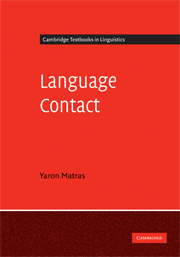Book contents
- Frontmatter
- Contents
- List of figures
- Preface
- List of abbreviations
- 1 Introduction
- 2 An emerging multilingual repertoire
- 3 Societal multilingualism
- 4 Acquiring and maintaining a bilingual repertoire
- 5 Crossing the boundaries: codeswitching in conversation
- 6 The replication of linguistic ‘matter’
- 7 Lexical borrowing
- 8 Grammatical and phonological borrowing
- 9 Converging structures: pattern replication
- 10 Contact languages
- 11 Outlook
- Notes
- References
- Author index
- Language index
- Subject index
5 - Crossing the boundaries: codeswitching in conversation
Published online by Cambridge University Press: 05 June 2012
- Frontmatter
- Contents
- List of figures
- Preface
- List of abbreviations
- 1 Introduction
- 2 An emerging multilingual repertoire
- 3 Societal multilingualism
- 4 Acquiring and maintaining a bilingual repertoire
- 5 Crossing the boundaries: codeswitching in conversation
- 6 The replication of linguistic ‘matter’
- 7 Lexical borrowing
- 8 Grammatical and phonological borrowing
- 9 Converging structures: pattern replication
- 10 Contact languages
- 11 Outlook
- Notes
- References
- Author index
- Language index
- Subject index
Summary
Defining codeswitching
Codeswitching is the term that is normally applied to the alternation of languages within a conversation. Some authors use ‘codemixing’ to refer to language mixing within the phrase or utterance, reserving ‘codeswitching’ for the alternation of languages in-between utterances or phrases (inter-sentential switching). Others employ ‘codemixing’ to denote the structures that are the product of language mixing and do not occur in the speech of monolinguals. Yet another use of ‘codemixing’ is as a cover term for various types of language mixing phenomena. In the absence of a general consensus, I shall be using the two terms – ‘codeswitching’ and ‘codemixing’ – interchangeably.
A distinction is commonly made between ‘alternational’ codeswitching – alternating languages between utterances or sentences –, and ‘insertional’ codeswitching – the insertion of a word or phrase into an utterance or sentence formed in a particular base or frame language (Muysken 2000a). As we shall see, the two phenomena are frequently, if not indeed generally, motivated by different functional goals. (Recall that in Chapter 2 we discussed the contrast between the insertional switch in Examples (33)–(35), and the alternational switch in Example (36).)
- Type
- Chapter
- Information
- Language Contact , pp. 101 - 145Publisher: Cambridge University PressPrint publication year: 2009
- 1
- Cited by

